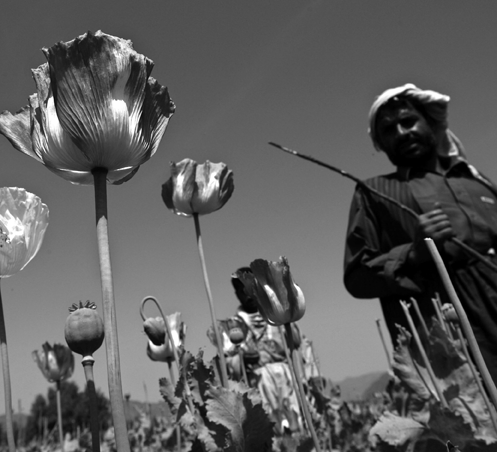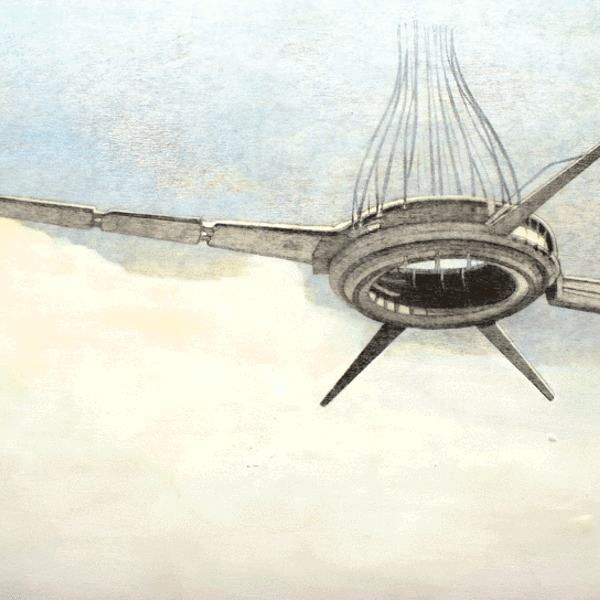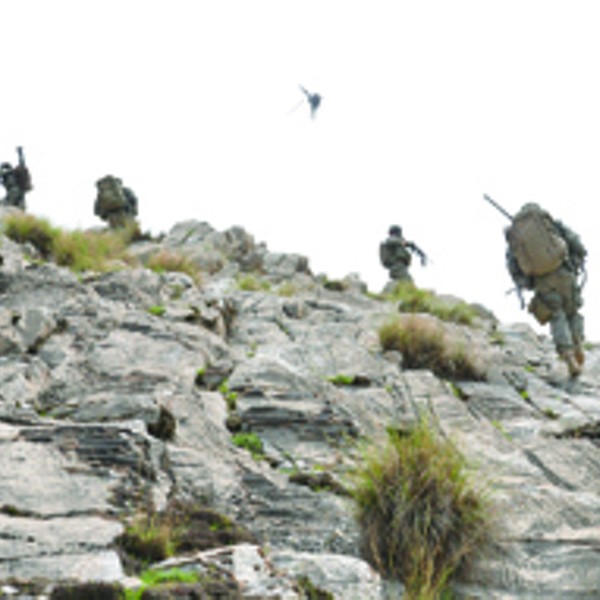A United Nations report released in late August revealed a second record year of opium cultivation in Afghanistan. The country had a 17 percent spike in cultivation this past year, and is now accounting for 93 percent of the world’s opium production (a one-percent increase in global market share over last year). One-hundred-and-ninety-three-thousand hectares of poppies were cultivated in Afghanistan, an area
larger than all the land used to grow coca in Latin America. Production continues to grow in spite of $600 million in American counternarcotics efforts and increased eradication by Afghan offi cials. “Afghanistan today is cultivating megacrops of opium,” said Antonio Maria Costa, the executive director of the United Nations Office on Drugs and Crimes Policy. “Leaving aside China in the 19th century, no other country has produced so much narcotics in the past 100 years.”
While opium cultivation is decreasing in the north, the south is seeing growth, especially in areas of Taliban influence where farmers are encouraged to grow the crop.
Source: The New York Times, Afghanistan Opium Survey 2007 Executive Summary (United
Nations), and US Counternarcotics Strategy for Afghanistan (US Department of State)
More than 200 trips taken by executive-branch officials between April 2006 and March 2007 were paid for by companies and trade organizations with interests in their agencies. The companies paying for the travel are regulated by or do business with government departments and agencies. “Corporations and trade associations want to pay for these trips for a reason, and that is to have face time with the regulators and government officials,” said Bill Hogan, director of investigative projects for the
Center for Public Integrity.
Rivanda Networks, a defense contractor, paid $4,200 in travel expenses for two
homeland defense officials from the Defense Department to attend a conference it sponsored in Limerick, Ireland. The Consumer Electronics Association, hosted 24 officials from various agencies at Las Vegas’s five-star Wynn hotel for its trade show atrip that cost the lobbying group $34,000.
Source: USA Today and The Hill
State and local governments across the nation offer $50 billion in tax breaks and business incentives annually to entice companies to relocate and retain existing businesses. North Carolina landed a $600 million Google server operation in March by offering $212 million in governmental assistance over 30 years. “But the impact of incentives dissipates quickly, so in a few years, there’s no benefit to employment,” said University of Nebraska economist John Anderson. Google is employing over 400 construction workers to build the plant. Once the plant is built, those jobs will dry up.
In September 2006, the Syracuse Post-Standard published a series exposing the fl awed Empire Zone program that provides $600 million in breaks annually to 9,800 businesses in New York state. It revealed that New York reimbursed NRG Energy, Inc., $22 million in property taxes in turn for one-half of a new full-time employee. Now states like New York are moving toward limiting such tax breaks and holding companies accountable to promises made when economic incentives were granted, by suspending benefi ts and enacting legislation to reform state incentive programs.
Source: USA Today, Computer World, and Syracuse Post-Standard
The UN Food and Agriculture Organization announced that since 1999, 2,000 breeds of livestock have been identified as at risk of extinction. As countries rely more heavily on higher-yielding American and European breeds to keep up with growing populations, they lose at least one indigenous breed a month. Within 20 years, Uganda’s Ankole, a breed of cattle known for its rich milk and tasty meat, may be extinct because farmers are moving toward the Holstein-Friesian breed that produces more milk,
now used in 128 countries. Of the 169 countries surveyed, almost 70 percent of the world’s unique livestock are found in developing nations. In 90 percent of industrialized nations only six specific breeds of cattle are used.
“In the US, Europe, China, India, and South America, there are well-established gene banks actively preserving regional livestock diversity,” said Dr. Carlos Seré, director general of the International Livestock Research Institute (ILRI). “Sadly, Africa has been left wanting and that absence is sorely felt right now because this is one of the regions with the richest remaining diversity and is likely to be a hotspot of breed
losses in this century.”
In the past six years the ILRI built the Domestic Animal Genetic Resources Information System, a database of the distribution, characteristics, and status of 669 breeds of indigenous livestock in Africa and Asia, including cattle, sheep, goats, pigs, and chickens. They seek to prioritize the breeds most at risk of extinction.
Source: Inter Press Service
Global warming and dry, dead wood built up in protected forests ignited megafires around the world, a trend that began a decade ago and continues to accelerate. Megafires are conflagrations that burn over thousands of miles with 20-foot-high flames and exceeding temperatures of 2,000 degrees Fahrenheit. They rage with no human way to suppress them, stopping only when they hit the coast or the weather changes drastically. The Great Fire Dragon that hit China in 1987 is the first blaze that could be characterized as a megafire, but it wasn’t until the late 1990s that the term was coined and the phenomenon reached a global scale.
Last year, five of Australia’s six states were hit, destroying 1.2 million hectares and killing two people. Firefighters from Canada, New Zealand, and the US joined the 15,000 Australian volunteers to combat the blazes. Australia is most prone to the fires, where in 2003 megafires caused a tornado in Canberra, but internationally fire trends are on the rise. This summer in Greece, 63 people died and 482,000 acres of land were lost to fires. Throughout Europe 1.9 million acres were blackened. The past decade has produced record year after record year of fires in the US. Last year, 9.6 million acres were charred, a significant increase from the 500,000 acres burned in 1998.
Source: The Independent (UK), Reuters, The Brookings Institution Center for Public
Policy Education
The Pentagon cannot account for 30 percent of the weapons issued to the Iraqi security forces in 2004 and 2005. The 190,000 missing AK-47 assault rifles and pistols lead some to worry that the weapons can be used against US troops. “They really have no idea where they are,” said Rachel Stohl, senior analyst at the Center for Defense Information. “It likely means that the United States is unintentionally providing
weapons to bad actors.”
The Government Accountability Office, which released the report, said since 2003 the US has spent $19.2 billion on developing the Iraqi security forces, including $2.8 billion to buy and deliver weapons. No central record exists of the weapons issued to security forces until December 2005, leaving a year-and-half of unaccounted weapon distribution.
Source: Washington Post
The United States was named most heavily armed society in the world in the “Small Arms Survey 2007.” The survey found that the US has 90 guns for every 100 citizens and 4.5 million of the 8 million manufactured every year globally are purchased by Americans.
India, who ranked second in citizen-owned firearms, has 46 million guns—a number dwarfed by America’s 270 million. With 40 million firearms, China is third.
The survey has a second list, which the US also tops, based on guns per capita. Yemen is second, with 61 guns for 100 citizens. Finland and Switzerland follow, with 56 and 46, respectively. Poorer nations that appear more violent fall lower on the list, as in the case of Nigeria that has one gun per 100 citizens. “Firearms are very unevenly distributed around the world,” said Small Arms Survey director Keith Krause. “The image we have of certain regions such as Africa or Latin America being awash with weapons—these images are certainly misleading.” The wealth of a nation is a larger indicator of weapon ownership than stability.
Source: Reuters
Afghan suicide bombings increased by 69 percent in the first eight months of 2007, according to a United Nations report. As of August, 103 Taliban-related suicide bombings took place, killing 200 people. In 2006, suicide bombings peaked at 123, while the year before ended with only 17. Afghanistan experienced one of the world’s highest number of suicide attacks in both 2006 and 2007—second only to Iraq.
Although 80 percent of those killed in Afghan suicide attacks this year were civilians, the Taliban targeted Afghan and international security forces and government officials, a noted difference from Iraqi suicide bombers who execute attacks in crowded marketplaces.
Source: The New York Times and Reuters

















